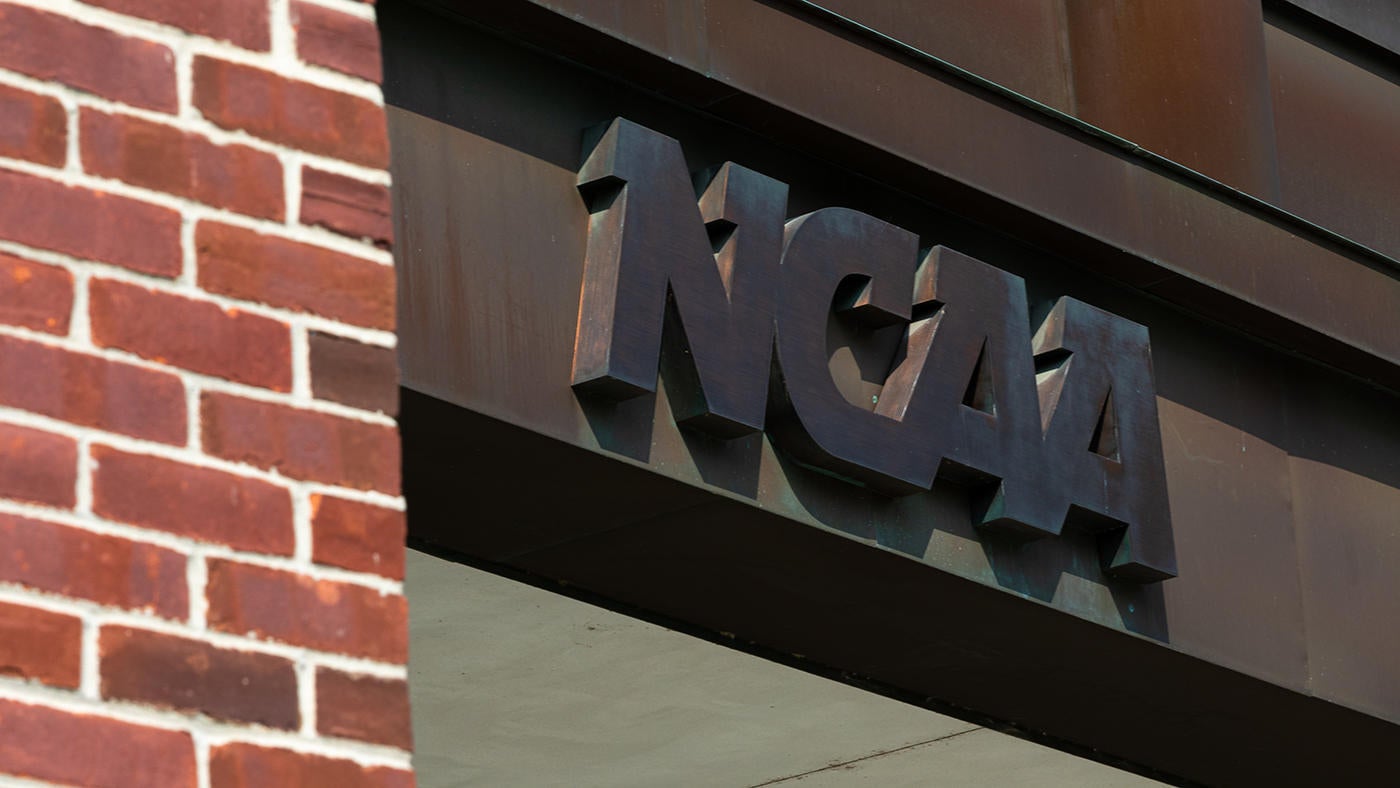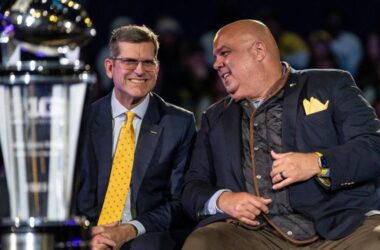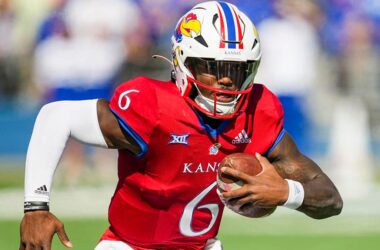
LAS VEGAS — In instances of economic strife, the NCAA and its colleges have at all times discovered a option to navigate murky waters.
In 1978, colleges voted to separate Division I into I-A and I-AA, consolidating energy into the palms of legacy applications with probably the most model worth and TV juice. We all know the 2 divisions right now as FBS and FCS, respectively.
Round that very same time, the Faculty Soccer Affiliation shaped. The CFA represented what primarily was the modern-day Energy 5 in TV negotiations. Worth in particular person conferences was discovered, which led to TV executives falling over themselves to safe broadcasting rights.
When cash turned scarce in 2006, colleges voted so as to add a twelfth regular-season recreation, mainly one other windfall of income for an additional dwelling tilt.
The BCS created a profitable entity upon its inception in 1998 that carries by means of to right now’s Faculty Soccer Playoff system: an on-field championship for which networks are comfortable to pay high greenback.
The enterprise now faces what would be the largest monetary disaster in its historical past, nonetheless. Division I is on the hook for the Home vs. NCAA settlement that tip toes proper as much as the sting of the cliff because it pertains to athletes changing into staff. Gamers have loved title, picture and likeness earnings for the previous few years, however the Home settlement permits income sharing for the primary time.
Solely a handful of athletic departments earn cash, and now the Energy 4 is about to be hit with roughly $22 million in income yearly to be shared with athletes.
“We have misplaced our voice of what faculty athletics is about,” Texas athletic director Chris Del Conte mentioned just lately. “Nobody needs to listen to that, however solely 2% of our student-athletes are going to go professional. The remainder of them are going to be medical doctors, legal professionals and nice productive residents.”
Disclaimer: Texas is probably the richest participant in that house. Del Conte can afford to write down an eight-figure examine again to the college every year. It might additionally afford each athlete profit allowed by the Home settlement.
All people else is kind of getting by utilizing inventive manners. The collegiate mannequin dictates that colleges spend as a lot as they make. That is why that cash has to go someplace, and often it goes to coaches’ salaries and services.
That is about to radically change.
“NIL, we must always have been doing within the ’90s,” outgoing Ohio State AD Gene Smith mentioned. “It took us seven years [of discussion] simply so as to add value of attendance. The income share we must always have been doing for a very long time.”
Cash not solely has be to raised post-Home, it needs to be reallocated to athletes like by no means earlier than. CBS Sports activities spent final week taking the temperature of a transitioning collegiate mannequin on the Nationwide Affiliation of Collegiate Administrators of Athletics (NACDA) conference.
The nation’s high ADs, directors and thought leaders had been in Las Vegas at a vital time. They’d many questions however few solutions. A imaginative and prescient of the longer term started to emerge, although. These are unprecedented instances for athletic departments to be going through that monetary strife. That should not be seen as a detrimental, nonetheless, as a result of athletes have lengthy been underserved.
The long run might be all about them gaining traction, energy and cash. The system is transitioning from being a paternal one overseeing these athletes to partnering with them.
Here is a peek at how that future is starting to look.
Getty Pictures
The Ohio State plan: At age 68, Smith is days away from retirement. Nonetheless, his counsel continues to be sought. Smith did not get to the purpose of working a soccer powerhouse and the most important athletic division within the nation sponsoring 36 sports activities with out having his personal imaginative and prescient.
At Ohio State, that features “stratification” of sports activities sooner or later. The time period is also called “tiering,” the place the longer term reallocation of funds will trigger some sports activities to be deemphasized.
On the backside finish, some Ohio State sports activities might be non-scholarship, which suggests no monetary support.
” … No summer season college support, no Alston support, low salaries for coaches,” Smith informed CBS Sports activities. “You alter your expectations [because] you are not going to pay the identical. It is an entire sequence of various issues to avoid wasting {dollars}.”
These deemphasized sports activities will play extra regionally, doubtless touring by bus as a substitute of flying.
After that, the center tier might be a mixture of scholarship and non-scholarship sports activities. At the moment, the NCAA permits full roster scholarships in solely 5 sports activities: soccer, males’s and ladies’s basketball, ladies’s volleyball and ladies’s tennis. The remainder are so-called “equivalency sports activities” the place scholarships could be shared throughout a spectrum.
With the Home settlement, colleges may have the possibility of absolutely funding sports activities like baseball that beforehand needed to unfold 11.7 scholarships over a roster of 35.
The highest tier might be absolutely funded, after all, beginning with soccer, basketball and regardless of the third-most standard sport is in any given convention.
“Then you need to decide what you are good at traditionally,” Smith mentioned. “[In evaluating how to prioritize sports], you begin with what number of colleges in your state sponsor that sport. What number of Massive Ten colleges sponsor that sport? What number of NCAA groups are there?”
After the 2029 fiscal 12 months, Ohio State is estimated to avoid wasting $8 million per 12 months with these strikes. (The financial savings will not hit till 2029 as a result of present scholarships should run their course.) The cash could possibly be rolled over into paying for among the income sharing payouts.
Ohio State won’t be alone in stratification. It has been talked about in faculty sports activities for some time. Smith mentioned there isn’t a plan to chop sports activities at Ohio State, however different colleges should make their very own choices. People who have just lately reduce sports activities have confronted authorized challenges and ethical outrage from dad and mom, supporters, and many others.
“You will have some colleges the place they will drop sports activities, however we will should stratify,” Smith mentioned. “Then you are going to have to alter expectations … Philosophically, each sport is chasing championships.”
Maybe not anymore.
Finish of the sports activities sponsorship minimal: On account of monetary pressures, subsequent up on the chopping block would be the NCAA mandate that colleges sponsor a minimal of 16 sports activities. That quantity was inserted years in the past partly to handle gender fairness; a sure share of these sports activities should be supplied for ladies. However the quantity more and more seems to be arbitrary, particularly because the NCAA’s energy continues to decrease and colleges get extra autonomy on balancing the books.
The considering goes: So long as colleges can adhere to Title IX, then they need to have the ability to sponsor as many, or as few, as they really feel applicable. Phrase circulated at NACDA that the NCAA Council — the affiliation’s chief day-to-day administrative physique — could have thought-about at the least decreasing the sports activities sponsorship minimal.
“The NCAA minimal might be going to alter,” Smith mentioned. “It is most likely going to go decrease. You are most likely going to see some conferences should resolve, ‘Are we going to maintain this many championships?'”
Coaches have misplaced credibility: Roster caps as a money-saving repair are all the trend post-Home. They’re being thought-about rather than scholarship limits to scale back prices in a local weather the place some colleges have rosters approaching 150. Roster caps would primarily finish the idea of walk-on, non-scholarship gamers who often are follow fodder. Coaches argue that walk-ons are wanted to assist develop gamers.
They haven’t backed up their argument. The primary scholarship limitations (105) had been applied in 1973.
“Joe Paterno and Tom Osborne acquired up [then] and talked about how soccer was going to die,” Smith mentioned.
In 1994, the restrict was lowered to 95. Just a few years later, it dropped to 85, the place it stands right now.
“The sport continues to be nice,” Smith famous.
A fast canvas of Energy 4 conferences over the previous three weeks revealed they’re contemplating anyplace from 85-120 for his or her roster caps. The irony (outrage?) is that the game that funds these aggrieved minor sports activities listed above is being requested to chop again. Keep tuned.
Non-public fairness workaround: The Massive 12 rocked the faculty sports activities world final week as CBS Sports activities reported the league was contemplating a non-public fairness play. Such a transfer would push the Massive 12 nearer to the SEC and Massive Ten when it comes to income. A lot in order that it conceivably may curiosity the likes of Florida State, Clemson and others if they can extricate themselves from the ACC.
However what if the Massive 12 — or different conferences — had been capable of pull off a bolder transfer? What in the event that they had been to funnel a few of that personal fairness cash by means of the convention itself as a option to keep away from Title IX gender fairness legal guidelines. Because it applies on this case, colleges should present scholarships that replicate the speed of participation in an athletic division.
Instance: If ladies make up 54% of a college’s sports activities individuals, between 53-55% of the scholarship cash should go to ladies.
Skirting Title IX would conceivably be an amazing recruiting benefit. A faculty may theoretically award an awesome share of that income cash to soccer and basketball gamers with out Title IX consequence.
“I am not assured that strategy will generate probably the most goodwill,” mentioned Alexis Trumble, a Title IX gender fairness lawyer primarily based in Atlanta. “It is actually not within the spirit of fairness, however there are actually some colleges which might be going to attempt it.
“I haven’t got an issue with personal fairness,” she added. “I’ve an issue with individuals making an attempt to skirt federal regulation.”
Getty Pictures
No gentle on the finish of the authorized tunnel: Few are acknowledging the potential of Choose Claudia Wilken not approving the forward-looking piece of the Home settlement, maybe as early as subsequent month. Len Simon is, although.
The veteran litigator of over 100 antitrust instances says Wilken’s approval “isn’t a foregone conclusion.” The a part of the settlement to which he is referring covers the income sharing facet the place the Energy 4 colleges every fund as much as $22 million per 12 months for the subsequent 10 years to pay gamers. The issue already seen by many is the cap on the quantity, which is on its face appears to be extra antitrust.
“It is a new value repair at totally different stage,” mentioned Simon, a Southern California-based lawyer who has been working class-action instances since 1974. “I believe you see what my frustration with it’s. It isn’t a union, it isn’t Congress. It isn’t something that is been anointed to fulfill with the NCAA, which has the pursuits of the colleges at coronary heart, and be throughout the desk on the opposite aspect and have the pursuits of the athletes at coronary heart.”
This can be a criticism that has emerged within the Home settlement. No precise athletes had a voice within the last settlement, a choice that may have an effect on them for at the least the subsequent decade.
“You often do not rejigger an business [with such a decision],” mentioned one veteran antitrust lawyer who most well-liked to stay nameless. “Who’s defending athletes within the ninth grade? No one.”
Lead Home lawyer Jeffrey Kessler informed CBS Sports activities final month the settlement “ought to resolve all of the antitrust points. There are non-antitrust points.”
A number of, really. There are two Nationwide Labor Relations Board on the West Coast that search to acknowledge athletes as staff. In Pennsylvania, Johnson vs. NCAA seeks a lot the identical factor. In March, a North Carolina tennis participant sued the NCAA over prize cash restrictions.
Final week, the nationwide championship-winning 1983 NC State basketball workforce sued over backpay for NIL advantages. What’s to maintain any championship workforce of notice in any 12 months from doing the identical? CBS Sports activities surveyed a number of attorneys on the topic. Their conclusion was one other Pandora’s Field opened up with comparable lawsuits was actually doable however these sort of lawsuits weren’t essentially winnable.
However as we have realized by means of all this, that is not essentially the purpose. The NCAA is sort of a battleship riddled with shells proper now. Merely suing the entity may sink it.
Keep in mind, a few of that settlement cash might be taken out of the NCAA Match distributions to varsities. Group of 5 directors who spoke to CBS Sports activities had been upset they had been included within the Home settlement. However they had been “responsible” by affiliation simply being an NCAA member. The Home plaintiffs sued the Energy 5 and the NCAA.
“There may be plenty of consternation from the Group of 5 establishments who didn’t have a seat on the desk,” Trumble mentioned. “You at the moment are on the hook for business adjustments that you weren’t essentially given a possibility to weigh in on.”
These 62 colleges at the moment are chargeable for paying some undetermined sum of money within the settlement. The typical Energy 5 college had a $98 million finances in 2022 in comparison with $33 million for the Group of 5.
This week, Les Miles sued the NCAA, LSU and Nationwide Soccer Basis claiming vacated wins from 2012-15 have eradicated his likelihood for a Faculty Soccer Corridor of Fame induction. The go well with, nonetheless, accommodates a few inaccuracies.
However as we have realized on the earth of dueling lawsuits, that is not the purpose. Somebody, someplace goes to should defend that go well with. In the meantime, colleges proceed to discover a option to navigate the monetary windfalls.
“It will be a extremely attention-grabbing subsequent few years as we attempt to shake out what this implies on the bottom,” Trumble mentioned. “As a result of proper now it is a fabulous regulation college hypothetical. However we aren’t enjoying with Monopoly cash. We aren’t enjoying with Lincoln Logs. We wouldn’t have machine-generated staff.”




